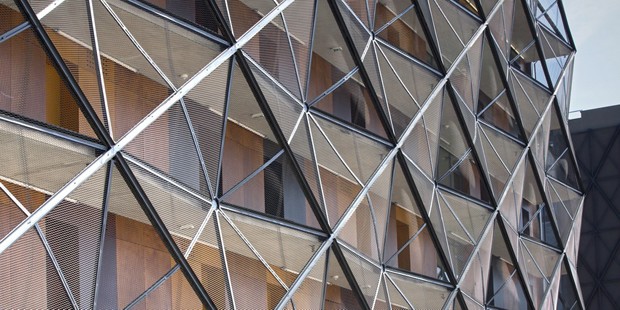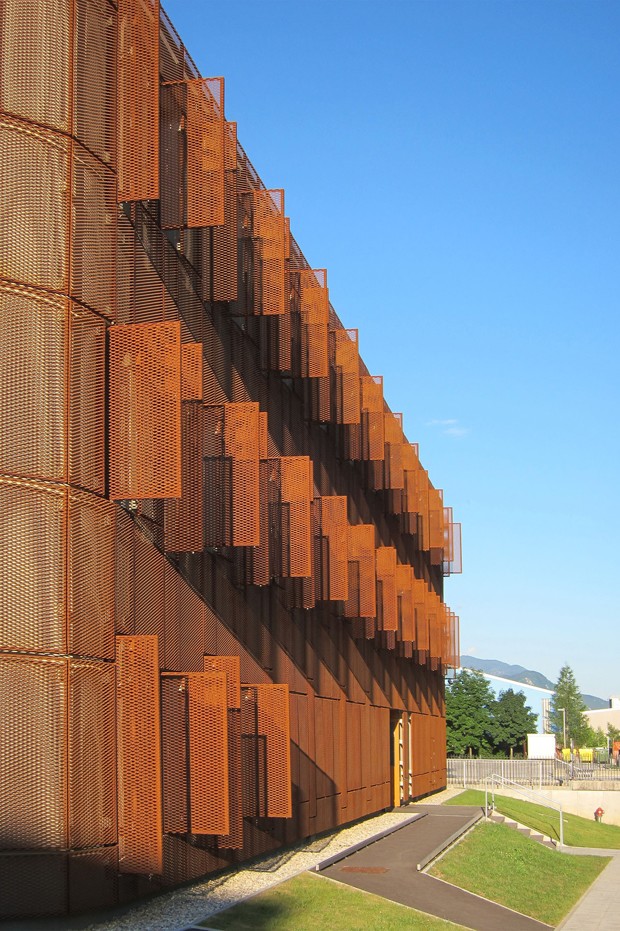If you attended this year’s DesignBUILD exhibition at the Sydney Showground, you almost certainly would have stopped to look at (and touch) the façade entrance feature by New Zealand architectural mesh company, Kaynemaile.
Flowing lightly down from the ceiling, wrapped around decorative lights, or tensioned onto balustrades, the Kaynemaile installation was an introduction to the reasons why projects are increasingly using architectural mesh on both facades and interiors.
Architectural mesh refers to any woven or welded wire mesh made of steel or other hi-tensile materials. For instance, Kaynemaile’s Building-Armour product, a single-sheet solution for façade cladding, is made with 100 per cent recyclable polycarbonate seamless mesh. Durable and lightweight, it joins other architectural mesh products in offering solar shading, and rain and wind screening benefits.
At the same time, architectural mesh can be utilised indoors to create privacy or breakout zones with large areas. It can even work as a retractable room divider or a custom-coloured fall protection screen.
We explore five projects from Australia and around the world that have tapped into the benefits of the material.
Basket Apartments by OFIS

 This 11-storey student housing project in Paris is located on a narrow site, with two different volumes presenting two different faces according to their function and program. On one façade, “studio balconies-baskets” of various sizes are made of HPL timber stripes, randomly oriented to diversify the views and rhythm of the façade. The other, overlooking a football field and consisting of an open passage walkway with studio entrances, features a 3D metal mesh enclosure.
This 11-storey student housing project in Paris is located on a narrow site, with two different volumes presenting two different faces according to their function and program. On one façade, “studio balconies-baskets” of various sizes are made of HPL timber stripes, randomly oriented to diversify the views and rhythm of the façade. The other, overlooking a football field and consisting of an open passage walkway with studio entrances, features a 3D metal mesh enclosure.
This mesh façade shades the western façade, but maintains views to the field, as well as the centre of Paris and the Eiffel Tower.

Images: Tomaz Gregoric. Source: OFIS
Melbourne School of Design by John Wardle Architects and NADAAA


At the centre of The University of Melbourne’s new Faculty of Architecture, Building and Planning is a four storey, light-filled atrium dominated by a timber-clad hanging studio and a grand scissor stairway that connects the levels. But it is a conspicuous stainless steel mesh from Tensile that gifts-wraps this space, providing a safety barrier between levels without compromising airflow and transparency requirements.
According to Tensile, the architects were drawn to using the Webnet mesh because of its “simplicity and almost ethereal veil”, which meant it did not fight with the hanging studio and communal spaces for attention.

Images: Tensile
Zafra-Uceda House by NO.MAD Arquitectos

This two-storey house in Aranjuez, Spain, features a wire-mesh façade on its south facing wall for very practical reasons – located on a golf course, the mesh essentially protects the occupants from stray golf balls.

 The results however, are much more refined than its reasons, with the façade inspired by crooked geometry and the potential to maintain restrictions on visibility and accessibility. Operable screens on the façade frame views for occupants, with the architects noting that those objects in the landscape are visually brought into the house, and defined by their relative position according to the inner programs on each level: “the mountain views from the living room, the old city and the river from the upper sleeping room and exterior terrace or the grass plot from the kitchen”.
The results however, are much more refined than its reasons, with the façade inspired by crooked geometry and the potential to maintain restrictions on visibility and accessibility. Operable screens on the façade frame views for occupants, with the architects noting that those objects in the landscape are visually brought into the house, and defined by their relative position according to the inner programs on each level: “the mountain views from the living room, the old city and the river from the upper sleeping room and exterior terrace or the grass plot from the kitchen”.
Images: Roland Halbe. Source: Dezeen
Administrative Centre Jesenice by Studio Kalamar

The Jesenice Administrative Centre is part of the Slovenian Ministry of Public Administration move to combine all state administrative functions into a single building. Directly addressing a large roundabout with a steel worker memorial at its centre, the building’s red-rust skin is a Corten steel mesh façade that speaks to the town’s steel manufacturing and industrial past.

Shutters in the façade allows natural light and ventilation into the building, while the panel shades work with good thermal insulation and quality window systems to lower the running costs of the building.
“A pulsing rhythm of facade openings creates a horizontal dynamics, establishing a dialogue with dynamics of the traffic,” say the architects.
“[The] facade system filters the aggressive contrast light into a softer diffuse light, thus encouraging use of natural light throughout the day. Building remains open into the environment while at the same time unobtrusively filtering everything that affects the wellbeing of its users.”

Images: Miran Kambic. Source: Studio Kalamar
The Ideal Electricity building by Thomas Chong Architect and BMC Architecture

The architects replaced the fire-damaged façade of the building in Lower Hutt, New Zealand, with Kaynemaile’s Building-Armour, a recyclable polycarbonate seamless mesh that provides a single-sheet solution for façade cladding. Fire resistant, lightweight and flexible, the product was primarily chosen by the architects because it provided solar shading to the interior without minimising visual connections from the building.
“Kaynemaile’s ability to filter sunlight to control solar gain, meant reduced cooling costs for the building whilst its high degree of transparency ensured views out of the building were not restricted,” said architect Thomas Chong.

Images: Kaynemaile

